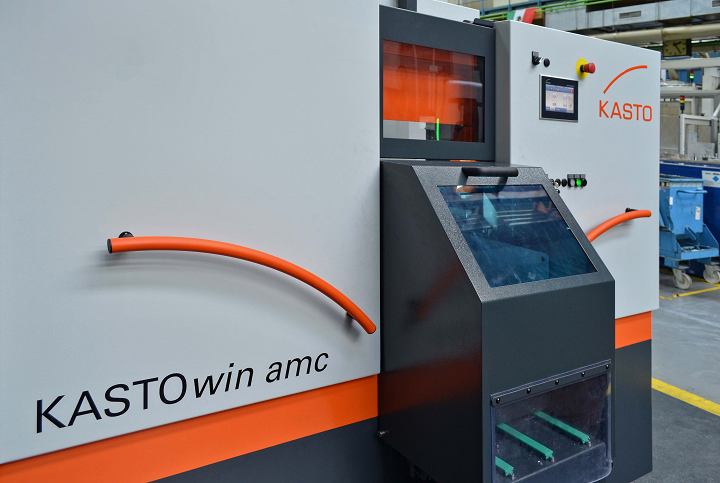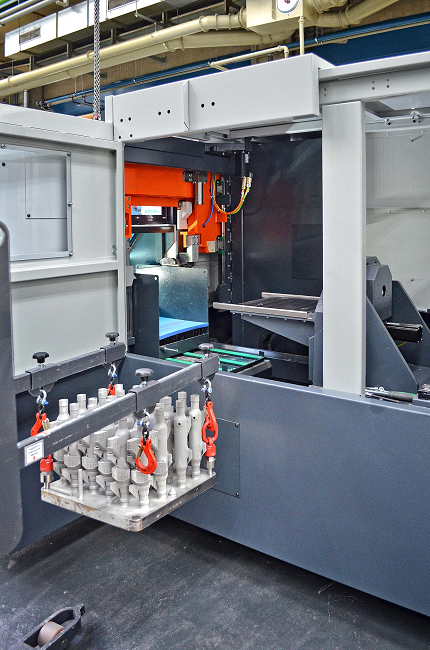3D printing is often used by companies to manufacture parts and components for helicopters, and Airbus Helicopters – part of the larger Airbus Group – is no exception. Just one year ago, Airbus Helicopters in Donauwörth, Bavaria began serial production of metal 3D printed door latch shafts for its A350 passenger aircraft, which helps save on costs, time, and weight.
 But we’re not talking about the 3D printed parts now – instead, I’m going to tell you about the efficient method the aerospace company is using to rapidly separate these parts from the base plate.
But we’re not talking about the 3D printed parts now – instead, I’m going to tell you about the efficient method the aerospace company is using to rapidly separate these parts from the base plate.
Last year, not long after serial production of the titanium shafts began, Airbus Helicopters purchased an automatic KASTOwin amc bandsaw from KASTO, another German company, in order to separate the parts from their base plate in an economic fashion without damaging them. The company conducted trials at KASTO’s Achern location ahead of time, and was impressed by how accurate, cost-effective, easy, and fast bandsawing was than other machining methods, like wire-cut EDM and milling.
The sawing machine manufacturer isn’t new to 3D printing – it’s actually a supporter of the NextGenAM collaborative project, and its automatic bandsaw was specifically designed to separate 3D printed components from the build platform by inverting them and sawing horizontally so that they fall into a container below.

Airbus Helicopters uses a KASTOwin amc bandsaw to separate 3D printed components from the base plate.
The Airbus Helicopters factory in Donauwörth uses powder bed 3D printing to fabricate the titanium shafts used to lock aircraft doors; the company also specializes in making the doors themselves for passenger and cargo aircraft. Each Airbus A350 aircraft has 16 of the components installed, and 3D printing is an ideal method of manufacturing due to the thin walls and complex geometry of the shafts.
When compared with conventional methods of manufacturing, these 3D printed titanium A350 shafts are 25% less expensive, and achieve weight savings of over 45%. But before they can be used, the components have to be separated from their 400 x 400 mm titanium base plate – precisely the task that the KASTOwin amc bandsaw was created to complete.

A batch of 3D printed titanium shafts for locking aircraft doors being delivered by fork lift to the KASTOwin amc.
The base plate with attached 3D printed shafts can weight up to 40 kg, so it has to be transported on a fork lift from the printer to the saw, then bolted to a clamping mechanism. The machine is fully enclosed, which prevents contamination of ambient air, in addition to preparing it for being connected to an extraction system.
Once the saw’s door is closed, the mechanism rotates through 180%, so that the sawing can be performed upside down. While this may sound like an odd setup for removal, it’s actually pretty advantageous – once the parts are cut, they can’t buckle or fall over, which helps prevent costly damage that would take precious time to fix.
After each build, the plate is ground flat so it can be used again, but it becomes thinner each cycle. So employees need to measure the base plate’s thickness while it’s clamped before sawing begins, and then input the figure into the AdvancedControl CNC’s job wizard. A high-precision ballscrew drive actuates the saw’s blade, and it’s then moved to the exact programmed height. Once they are cut, the 3D printed titanium shafts then drop into a container, which is padded to further prevent damage, and an employee removes them through a flap.

Bandsawing is performed in the KASTOwin amc with the workpieces inverted to prevent damage to the expensive 3D printed parts after their separation from the base plate.
Airbus Helicopters plans to 3D print other metal components at its Donauwörth factory, which means that the KASTOwin amc bandsaw will likely be seeing a lot more use.
Discuss this story and other 3D printing topics at 3DPrintBoard.com or share your thoughts in the Facebook comments below.
Subscribe to Our Email Newsletter
Stay up-to-date on all the latest news from the 3D printing industry and receive information and offers from third party vendors.
You May Also Like
Profiling a Construction 3D Printing Pioneer: US Army Corps of Engineers’ Megan Kreiger
The world of construction 3D printing is still so new that the true experts can probably be counted on two hands. Among them is Megan Kreiger, Portfolio Manager of Additive...
US Army Corps of Engineers Taps Lincoln Electric & Eaton for Largest 3D Printed US Civil Works Part
The Soo Locks sit on the US-Canadian border, enabling maritime travel between Lake Superior and Lake Huron, from which ships can reach the rest of the Great Lakes. Crafts carrying...
Construction 3D Printing CEO Reflects on Being Female in Construction
Natalie Wadley, CEO of ChangeMaker3D, could hear the words of her daughter sitting next to her resounding in her head. “Mum, MUM, you’ve won!” Wadley had just won the prestigious...
1Print to Commercialize 3D Printed Coastal Resilience Solutions
1Print, a company that specializes in deploying additive construction (AC) for infrastructure projects, has entered an agreement with the University of Miami (UM) to accelerate commercialization of the SEAHIVE shoreline...





























